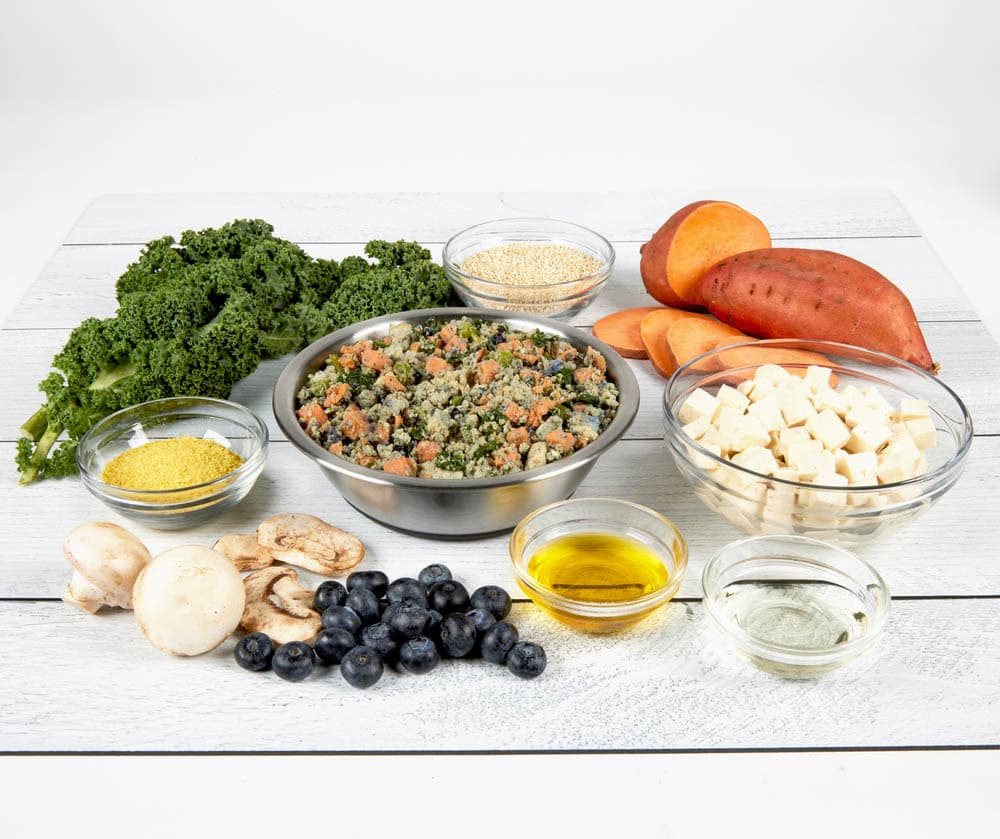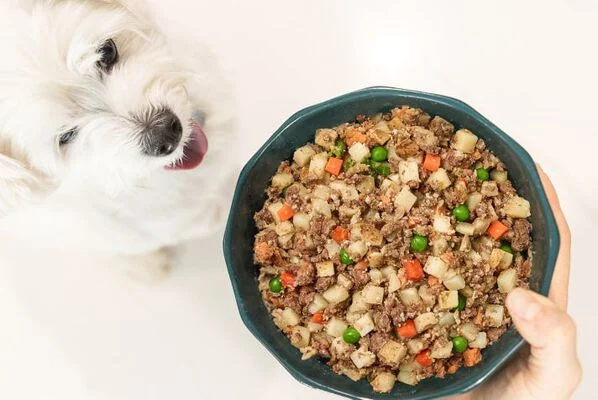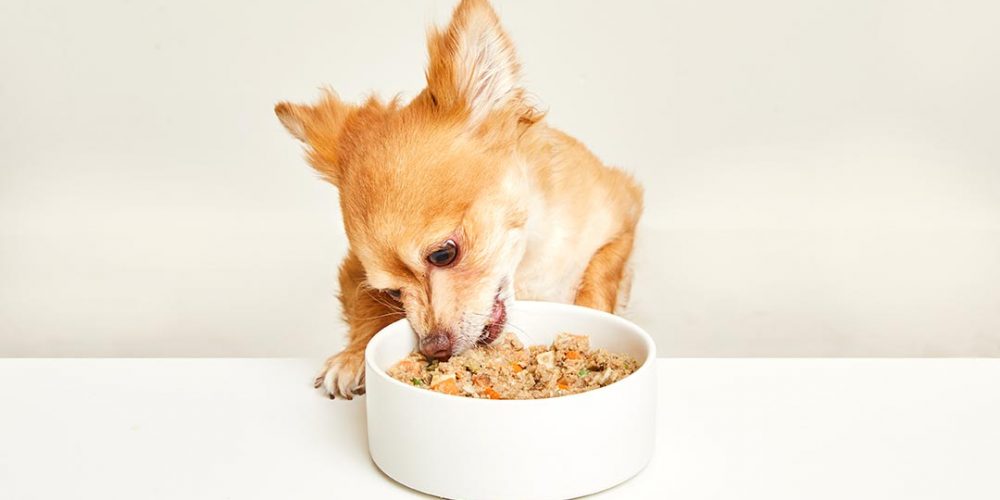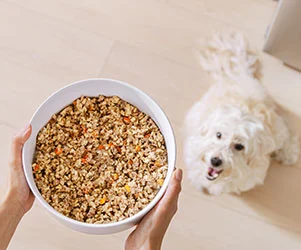We’ve all thought about it. Maybe it was out of curiosity, during a late-night snack crisis, or because the smell made you wonder—can humans eat dog food? A fresh bag or can smells appetizing, and the ingredients list reads like a gourmet human meal, with beef, carrots, and sweet potatoes. What’s stopping you?
Technically, humans can eat dog food. But should you? Let’s dive into the differences between food prepared for humans and dogs, and what would happen if you started eating a dog-food-only diet.
Dog food ingredients

The ingredients in commercial dog food are similar to those in a human diet. Animal products, healthy vegetables and fruits, and grains have their place in pet food. And while dog food made from ingredients like beef, chicken, rice, sweet potatoes, and peas sounds like a home-cooked meal, dog food formulas are specifically designed to meet the nutritional needs of dogs, not humans.
Here’s how dog food differs from a human diet:
- Micronutrients — Dog food is typically higher in vitamin A and calcium, but lower in vitamin C. Nutrient ratios for dogs may also differ from human needs.
- Macronutrients — The protein, fat, and carbohydrate ratios in dog food vary considerably, but likely contain more fat and protein than the average human diet.
- By-products — Many dog foods include meat by-products, meat meals, and offal (i.e., organ meat), which people avoid eating. These ingredients are unappealing to humans, but they are nutrient-dense and beneficial for dogs.
The history of dog food
Before commercial dog food became widely available in the early 20th century, dogs primarily ate table scraps or raw meat. However, as the pet population grew, food manufacturers developed formulas tailored to meet the specific nutritional needs of dogs. The first commercial dog biscuits were introduced in England in the 1860s, followed by canned meat-based diets in the U.S. in the 1920s.
Modern dog food is highly regulated and carefully formulated, but it remains fundamentally different from food grown and processed for human consumption.
Understanding dog food regulation
Two leading authorities oversee dog food labeling and safety standards:
- Association of American Feed Control Officials (AAFCO) — Sets nutritional standards and model regulations for pet food.
- Food and Drug Administration (FDA) — Ensures that pet food is truthfully labeled and free from harmful contaminants
Despite these agencies regulating both people and dog food, each is categorized and treated differently. The FDA’s goal is to maximize safety for pets eating the food while also ensuring minimal risk to people in contact with the food. According to the agency, pet food must be safe to eat, produced under sanitary conditions, contain no harmful substances, and be truthfully labeled.
If a dog food doesn’t claim to use human-grade ingredients, it’s processed in facilities not inspected for human consumption and may contain ingredients deemed unfit for the human food supply chain.
Is it safe for humans to eat dog food?

Sampling a kibble or a spoonful of canned food to see how it tastes won’t harm you. Although there are many people foods that are toxic to dogs, the opposite is not true. In small amounts, dog food is unlikely to cause immediate harm. However, long-term consumption could be risky.
Unlike food made for humans, dog food:
- May contain animal parts not approved as safe for human consumption.
- May contain synthetic additives, like vitamin K3 (menadione), which is banned from use in human supplements due to potential toxicity
- Might undergo less rigorous testing for foodborne pathogens, such as Salmonella, E. coli, or Listeria monocytogenes
- May not meet human nutritional standards for daily intake of various nutrients, such as fiber.
While the FDA regulates the safety and labeling of dog food, its standards differ significantly from those governing human food. For example, the FDA doesn’t require pet food to be produced in USDA-inspected facilities unless it’s labeled “human-grade.”
What happens if you eat dog food all the time?
If you were to eat nothing but dog food every day, you could eventually develop nutritional deficiencies, especially in vitamins that dogs can produce but humans can’t, like vitamin C. You may develop:
- Scurvy from vitamin C deficiency
- Gastrointestinal issues from a lack of dietary fiber
- Compromised immune function from nutrient imbalances
- Foodborne illness from accidental contamination
What about fresh dog food with human-grade ingredients?

Fresh food brands like JustFoodForDogs make whole-food diets for dogs using USDA-certified meats, vegetables, and whole grains slated for human consumption. These meals are prepared in small batches in kitchens that meet standards for both pet and human food safety.
Dog food labeled as human-grade is:
- Sourced from approved, traceable suppliers.
- Developed by veterinary nutritionists to be complete and balanced for dogs.
- Cooked in kitchens that follow FDA and USDA guidelines to reduce contamination risks.
Many people who try human-grade food for dogs think it tastes better than standard dog food, but that doesn’t make it nutritionally complete for humans or a suitable substitute for your own food.
The human-grade distinction

The term “human-grade” is often confused with marketing jargon that doesn’t mean the same thing. True human-grade dog food consists of ingredients that are approved for human consumption and is prepared, handled, and stored in a facility that meets all FDA and USDA standards for human food production.
This differs from “human-quality” or “made with real food,” statements with no standardized meaning in the industry. Claims like these may refer to individual ingredients but don’t guarantee that the product meets regulatory standards.
At JustFoodForDogs, we wholly embrace the concept of human-grade food. We prepare our safe recipes in open-to-the-public kitchens using 100% human-edible ingredients and follow the same food safety and handling protocols you’d expect in a commercial kitchen.
So while our meals are designed for dogs, they’re prepared with the same care and cleanliness as food made for you.
Key takeaways: Can humans eat dog food?
- A small amount of dog food is unlikely to harm a healthy adult human. Individuals with weakened immune systems should avoid handling or consuming dog food.
- Eating dog food only would likely lead to nutritional deficiencies and expose to foodborne illness risks.
- Fresh dog food made with human-grade ingredients is the cleanest and safest option, but it is still not intended for human consumption.
Food for thought
If you find yourself tempted to eat your dog’s food, it might be time to evaluate your grocery list.
Dog food is formulated to support canine health, not human digestive systems. While high-protein, whole-food meals made with human-grade ingredients are a step above traditional dry dog food or kibble, they’re still meals designed for dogs, a species with different nutritional requirements from our own.
Want to feed your dog meals that are safe, simple, and made with ingredients you recognize? JustFoodForDogs makes home-cooked meals in our commercial kitchen, including custom formulations. Check out our blog to learn more about dog food safety and the benefits of fresh dog food diets.
Sources
Sanderson, Sherry Lynn. 2023. “Nutritional Requirements of Small Animals – Management and Nutrition.” MSD Veterinary Manual. November 2023. https://www.msdvetmanual.com/management-and-nutrition/nutrition-small-animals/nutritional-requirements-of-small-animals.
escapehatch. 2024. “The History of Pet Food – Pet Food Institute.” Pet Food Institute. May 20, 2024. https://www.petfoodinstitute.org/the-history-of-pet-food/.
Medicine, Center for Veterinary. 2021. “Vitamin K Substances and Animal Feed.” FDA, April. https://www.fda.gov/animal-veterinary/safe-feed/vitamin-k-substances-and-animal-feed.
“The A-B-C’s of Vitamin c – Petfoodology.” 2018. Tufts.edu. April 28, 2018. https://sites.tufts.edu/petfoodology/2018/04/28/the-a-b-cs-of-vitamin-c/.
“AAFCO Standard for ‘Human Grade’ Pet Food.” n.d. Accessed July 10, 2025. https://www.aafco.org/wp-content/uploads/2023/01/AAFCO_Human_Grade_Standards_AMS.pdf.
This content is for informational use only and does not replace professional nutrition and/or medical advice, diagnosis, or treatment. It is not a substitute for and should not be relied upon for specific nutrition and/or medical recommendations. Please talk with your veterinarian about any questions or concerns.






